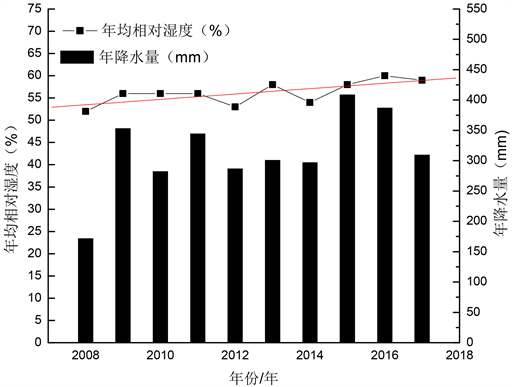摘要:
近年来,随着全球经济与人类社会的发展,温室效应日益严重,引起气候变化、全球变暖等一系列效应,对人类环境、经济、气候等均产生严重影响。根据中国统计年鉴数据,对乌鲁木齐市2008~2017这十年的气温、降水和平均相对湿度进行统计分析,研究其气候变化趋势。结果表明,近十年来,乌鲁木齐市年平均气温呈波动上升的趋势,气温年较差较大,平均年较差约37℃;最冷月与最热月气温相差很大,7月气温最高,1月气温最低,差值为36.9℃;年极高温与年极低温之差平均在60.6℃左右;年降水量自2008年后显著增加,降水量主要集中在4月,而1月的降水量最少,年降水量相差较大,2015年降水量最多,为408.9 mm,2008年降水量最少,为171.8 mm,降水幅度差为237.1 mm,年降水量有上升的趋势;年平均相对湿度缓慢上升。乌鲁木齐市的气候特征是冬季寒冷湿润,夏季炎热,蒸发量大,夏、秋季干燥,年温差较大,其气候有朝温暖湿润发展的趋势。
Abstract:
In recent years, with the development of global economy and the improvement of human living standard, the greenhouse effect is becoming more and more serious, causing a battery of effects such as climate change and global warming, which have a severe impact on human environment, economy, and climate and so on. According to the statistical yearbook of China, the temperature, precipitation and average relative humidity of Urumqi during 2008-2017 were analyzed, the cli-mate change trend was studied. The results show that in recent ten years, the average annual temperature fluctuates and rises in Urumqi, the annual temperature range is large, and the aver-age annual difference is about 37˚C. The temperature difference between the coldest and the hot-test months is big, the highest temperature is in July and the lowest temperature in January, the difference value is 36˚C. The difference between annual extremely high temperature and annual extremely low temperature is about 60.6˚C. Average annual precipitation has increased signifi-cantly since 2008, the precipitation mainly concentrates on April, the minimum precipitation is in January, and annual precipitation varies greatly. In 2015, the precipitation is the most, 408.9 mm. In 2008, the precipitation is the least, 171.8 mm, the difference of precipitation amplitude is 237.1 mm, annual average precipitation has a tendency to rise, the annual average relative humidity in-creases slowly. The climate characteristics of Urumqi are cold and wet winter and hot summer, evaporation is big, summer and autumn are dry, the climate tends to be warmer and wetter.
1. 引言
近年来,由于人类社会的发展,大量焚烧化石燃料,如煤、石油等,产生了大量CO2,此外还有许多活动,如森林植被的砍伐与焚烧、机动车的使用量大幅度增加、人口数量剧增等,也将产生大量CO2等温室气体,这些温室气体将导致温室效应,使地球的温度上升。张志高等 [1] 研究表明近100年来,地球气候正在经历以全球变暖为主要特征的变化。温室效应将产生十分严重的后果,不仅使冰川消融,海平面上升,危及到人类的生存,而且将破坏生态系统,使全球降水量重新分配。温室气体会改变地表的能量平衡,使得部分地区气候异常,而出现洪涝和干旱等极端天气现象,也会增加地表的蒸发率,造成水资源的区域性短缺,使得全球干旱和半干旱地区有进一步变干的趋势,因此,温度的变化一直以来都是人类重点关注的问题。
陈隆勋等 [2] 研究表明,中国自20世纪40年代到达20世纪的第一个暖期后,50年代气温急剧下降,随后呈波动变化,80年代后,气温又急剧上升,90年代达到20世纪的第二个暖期,全国年平均气温50年中上升了0.3℃,但没有超过40年代的气温。新疆地域辽阔,有冰川约18,600条,河流570多条。天山是世界七大山系之一,平均海拔约4000 m,全长约2500 km,在中国新疆境内绵延大约1760 km,新疆天山又称雪山,因冬夏有雪而得名,其南坡雪线高度约为3900~4200 m,北坡雪线高度约为3500~3900 m。近年来,受温室效应和人类活动等因素的影响,天山冰川消融的速度逐渐加快,据研究,天山一号冰川平均每年退缩4~8 m,大气温度平均升高0.8℃,天山一号冰川的面积平均缩小14%。冰川消融使雪线呈升高趋势,对气候将产生很大影响。普宗朝等 [3] 通过分析乌鲁木齐市1971~2000年不同海拔高度气温、降水、无霜期及气温日较差等气候要素的变化趋势,指出乌鲁木齐市近30年来气温变暖率超过了全球及全国平均值,并且冬季变暖率以每10年增加0.701℃的趋势上升。冰川消融使固体水资源的储量减少,降水时空格局发生改变,对干旱区造成水资源短缺,新疆自然条件复杂,又具有明显的地域性特点,且生态系统薄弱,气候的异常变化会带来极端天气事件,如干旱、洪涝、暴雪等。对干旱地区的新疆来说,气候变暖、降水增加与其带来的灾害相比,有利的方面可能会更多一点,因为这会使农业带有向北推移的趋势 [4] 。
新疆位于中国的西北边陲,是中国陆地面积最大的省级行政区。其地处东经73˚40'~96˚18',北纬34˚25'~48˚10'之间。由于新疆远离海洋,深居内陆,且受到四周地形的阻挡,湿润气团很难到达,所以形成了明显的温带大陆性气候,使新疆冬季严寒,夏季炎热,气温年差较大,日较差也很大,气候干燥,降水量少。乌鲁木齐地处东经86˚37'33~88˚58'24,北纬42˚45'32~45˚00'00,位于中国西北部,新疆中部,天山北麓,毗邻中亚各国,有“亚心之都”的称号。乌鲁木齐是世界上离海洋最远的城市,属温带大陆性干旱气候。气候干燥、降水少、蒸发量大,造成水资源短缺,制约了当地社会经济发展尤其是农牧业经济发展和生态环境保护 [5] [6] 。以统计年鉴数据为依据,通过对新疆乌鲁木齐市2008~2017年间年均温、月均温、年极端最高温、年极端最低温、年降水量、各月降水量、年均相对湿度进行统计,研究其近十年的气候变化趋势及其气候特征。
2. 资料来源与方法
2.1. 资料来源
平均气温、降水量、平均相对湿度等数据均源于中国统计年鉴。
2.2. 研究方法
查阅乌鲁木齐市2008~2017年间的各月气温、年均气温、年极端最高温、年极端最低温、各月降水量、年降水量及平均相对湿度等数据,利用Origin85软件做出年均气温、年降水量及年均相对湿度的图形,对年均相对湿度进行线性拟合,得出拟合方程,结合图形和拟合方程研究年均相对湿度的变化趋势;利用Excel软件得到年均气温的趋势线方程,由图形和趋势线方程得出十年内乌鲁木齐市气温的变化趋势和上升率;通过求平均值得到十年月均气温、月均降水量的数据,作差得到年极高温与年极低温之差的数据,整理数据并分别进行分析讨论,研究十年间乌鲁木齐市的气候变化状况。
3. 结果与讨论
3.1. 2008~2017年各月平均气温变化
乌鲁木齐市2008~2017年的各月平均气温、十年月均气温见表1。由此表可知,7月平均气温为全年最高,为24.77℃,1月为全年最低,为−12.1℃,相差36.9℃。11月、12月、1月、2月这四个月为较冷月,均温在0℃以下,其余月份平均气温均在0℃以上;3~4月月平均温差最大,达11.43℃,平均年较差约37℃。在2008~2017年间,1月的平均气温为−12.1℃,其中2008、2011、2012年的平均气温低于月平均气温;2月的平均气温为−9.94℃,其中2010、2012、2013、2014年的平均气温低于月平均气温;3月的平均气温为0.51℃,其中2010、2011、2012、2014、2017年的平均气温低于月平均气温;4月的平均气温为11.94℃,其中2008、2010、2014、2017年的平均气温低于月平均气温;5月的平均气温为17.67℃,其中2009、2010、2011、2013、2016年的平均气温低于月平均气温;6月的平均气温为22.62℃,其中2008、2009、2010、2013、2014、2015年的平均气温低于月平均气温;7月的平均气温为24.77℃,其中2008、2015、2017年的平均气温高于月平均气温,其余均低于平均气温;8月的平均气温为23.08℃,其中2009、2010、2013、2015年的平均气温低于月平均气温;9月的平均气温为17.48℃,其中2008、2009、2014、2015、2017年的平均气温低于月平均气温;10月的平均气温为−0.39℃,其中2012、2015、2016、2017年的平均气温低于月平均气温;11月的平均气温为17.48℃,其中2009、2012、2016年的平均气温低于月平均气温;12月的平均气温为−8.42℃,其中2009、2011、2012、2014年的平均气温低于月平均气温。由此表可看出,乌鲁木齐市在2015、2016年冬季的气温明显低于其他年份,而冬季变暖的现象将会产生十分恶劣的影响。2010年1月北疆地区发生了极端升温过程,造成北疆塔额盆地积雪在隆冬时节快速消融,发生冬季融雪型洪水 [7] 。2015~2016年冬季变暖是受到厄尔尼诺现象的影响,厄尔尼诺带来的直接影响就是使温度上升,扰动大气环流,而使极端天气现象频发,对新疆造成的影响是暖冬的频繁出现,暖冬现象使新疆冬季暖湿气候明显,大雾天气较历年同期明显增多,对道路交通、航空、能见度等均带来很大影响。

Table 1. Temperature in Urumqi from 2008 to 2017
表1. 2008~2017年乌鲁木齐市气温情况
2008~2017年乌鲁木齐市的年均气温变化见图1,由此图可看出,乌鲁木齐市10年来气温变化较大,2015年年平均气温为最高值,为8.8℃,2011年年平均气温为最低值,为7.3℃,其差值为1.5℃。2008~2011年年平均气温呈下降趋势,随后又呈波动上升的趋势,秦大河等 [8] 研究表明,近40年我国的年平均气温以0.22℃/10a的倾向率上升,徐影等 [9] 也研究提出,西北地区有气温升高、降水量增加的趋势。对2008~2017年乌鲁木齐市年均气温进行线性趋势分析,得到趋势线表达式为:
(1)
可知乌鲁木齐市年均气温以0.47℃/10a的倾向率上升,与全球变暖的整体趋势相同。
3.2. 2011~2017年各月极端气温
2011~2017年乌鲁木齐市各月极端气温见表2。乌鲁木齐市的年温差很大,极高温与极低温之差平均在60.6℃左右,在2011~2018年间,极端最高温在2015年7月达到最高,为41℃,极端最低温在2012年12月达到最低,为−29℃。极端最高温与极端最低温在2011年相差最大,其差值为66℃。极端最高温一般出现在7月,而极端最低温一般出现在1月。IPCC第五次评估报告重点对极端事件变化进行了评估,表明在全球变暖背景下,各地极端天气气候事件规律发生变化将导致区域气象灾害频发,灾害风险加剧 [10] ,由以上数据可以看出,乌鲁木齐市的温差较大,月气温的变化幅度也很大,说明乌鲁木齐市易发生干旱、暴雪等自然灾害。全球变暖升高的幅度使大汽中的水汽含量增加,冬季降水增加从而使积雪有增加的趋势 [11] ,2015年10月,乌鲁木齐市遭暴雪袭击,积雪深度超过37 cm,突破乌鲁木齐市冬季历史极值。由此表还可看出,年极端最高温呈上升趋势,年极端最低温也呈上升趋势,且年极端最低温上升比较明显,可见乌鲁木齐市气温在朝温暖发展,这种发展趋势将使天山雪线上升,冰川面积减少,导致新疆地区水资源短缺,极端天气事件频发,气候更加干旱。

Figure 1. Annual average temperature change in Urumqi from 2008 to 2017
图1. 2008~2017年乌鲁木齐市年均气温变化情况


Table 2. Extreme temperature of each month in Urumqi from 2008 to 2017
表2. 2011~2017年乌鲁木齐市各月极端气温
3.3. 降水量
2008~2017年乌鲁木齐市的每月降水量、年降水量、月均降水量见表3,年降水量变化如图2。由此表可知,乌鲁木齐市在4月的降水量最多,为47.23 mm,1月的降水量最少,为9.27 mm,相差37.96 mm,主要降水集中在4~6月和10~11月。

Table 3. Precipitation in Urumqi from 2008 to 2017
表3. 2008~2017年乌鲁木齐市降水量情况
2008~2017年乌鲁木齐市的平均降水量为314.23 mm,2015年的降水量最多,为408.9 mm,其次为2016年,降水量为387.1 mm,2008年的降水量最少,为171.8 mm,年降水量最多与最少之间的差值为237.1 mm,年降水量变化波动较大,说明干旱和极端强降水等灾害频发。在超强厄尔尼诺现象背景下,2016年全疆平均降水量异常偏多,较常年增多近5成,达247.6 mm,为1961年以来历史最高,造成暴雨洪水等气象灾害,衍生地质灾害有雪灾、冻雨、大风等。2008年,新疆出现历史上第二个严重干旱年,仅次于1974年,全疆大部分地区气温持续偏高,降水量明显偏少,全疆平均降水量为59 mm,于常年同期相比偏少24%,新疆大部分地区遭受了严重的春夏连旱,农作物受灾严重,部分地区几乎绝收,大面积天然草场严重受旱,占可用草场面积的38%。2012~2014年的降水量较稳定,自2008年之后,降水量显著增加,朱蕾 [12] 研究指出,乌鲁木齐降水具有显著的3~5年振荡周期,由图2可知,近10年来,降水量呈波动上升趋势,有显著的振荡周期。

Figure 2. Annual average relative humidity and annual precipitation in Urumqi from 2008 to 2017
图2. 2008~2017年乌鲁木齐市年均相对湿度与年降水量变化
3.4. 平均相对湿度
乌鲁木齐市2008~2017年平均相对湿度见表4,年均相对湿度变化如图2。杨静等 [13] 通过对乌鲁木齐市相对湿度的气候分析,表明乌鲁木齐市相对湿度的月变化为冬季偏高,春、夏、秋季偏小且三季总体变化幅度不大。由此表可知,12月为最湿润的月份,月平均相对湿度为77.4%,5月为最干旱的月份,月平均相对湿度为38.5%,1月、2月、11月、12月为较湿润的4个月份,平均相对湿度为76.7%,5月、6月、7月、8月、9月为相对干旱的4个月份,平均相对湿度为40.18%,说明乌鲁木齐市进入春季时间较晚,进入秋季时间较早,夏季炎热,蒸发量大,冬季寒冷,蒸发量小。由图2可知,自2008年以来,乌鲁木齐市的年平均相对湿度逐渐上升,2009~2011年较稳定,2016年最为湿润,达60%,对2008~2017年乌鲁木齐市年均相对湿度进行线性拟合(图2)结果表明,年均相对湿度(y)与年份(t)的线性关系较好,拟合方程为:
(2)
施雅风等 [14] 研究表明,在1987年前后,我国西北地区的气候发生了由暖干向暖湿转变的现象,由图2可知,近十年乌鲁木齐市年平均相对湿度有缓慢上升的趋势,可见乌鲁木齐市的气候与研究一致,有由干向湿转变的趋势。

Table 4. Average relative humidity in Urumqi from 2008 to 2017
表4. 2008~2017年乌鲁木齐市平均相对湿度
4. 结论
近十年来,乌鲁木齐市年平均气温呈波动上升的趋势,气温年较差较大,平均年较差约37℃,最冷月与最热月差值很大,7月气温最高,1月气温最低,差值为36.87℃;年极端最高温和年极端最低温相差也很大,差值平均在60.6℃左右,且年极端最高温和年极端最低温都有上升的趋势,但年极端最低温上升幅度更大,说明乌鲁木齐市易发生干旱、暴雪等自然灾害;年降水量自2008年后显著增加,降水量主要集中在4月,而1月的降水量最少,年降水量相差较大,2015年降水量最多,为408.9 mm,2008年降水量最少,为171.8 mm,降水幅度差为237.1 mm,表明干旱和极端强降水等天气事件频发,年降水量有上升的趋势;年平均相对湿度逐渐升高。由此可预测,乌鲁木齐市的气候有朝着暖湿发展的趋势。
基金项目
兰州城市学院第五届“挑战杯”大学生课外学术科技作品竞赛项目。
NOTES
*通讯作者。